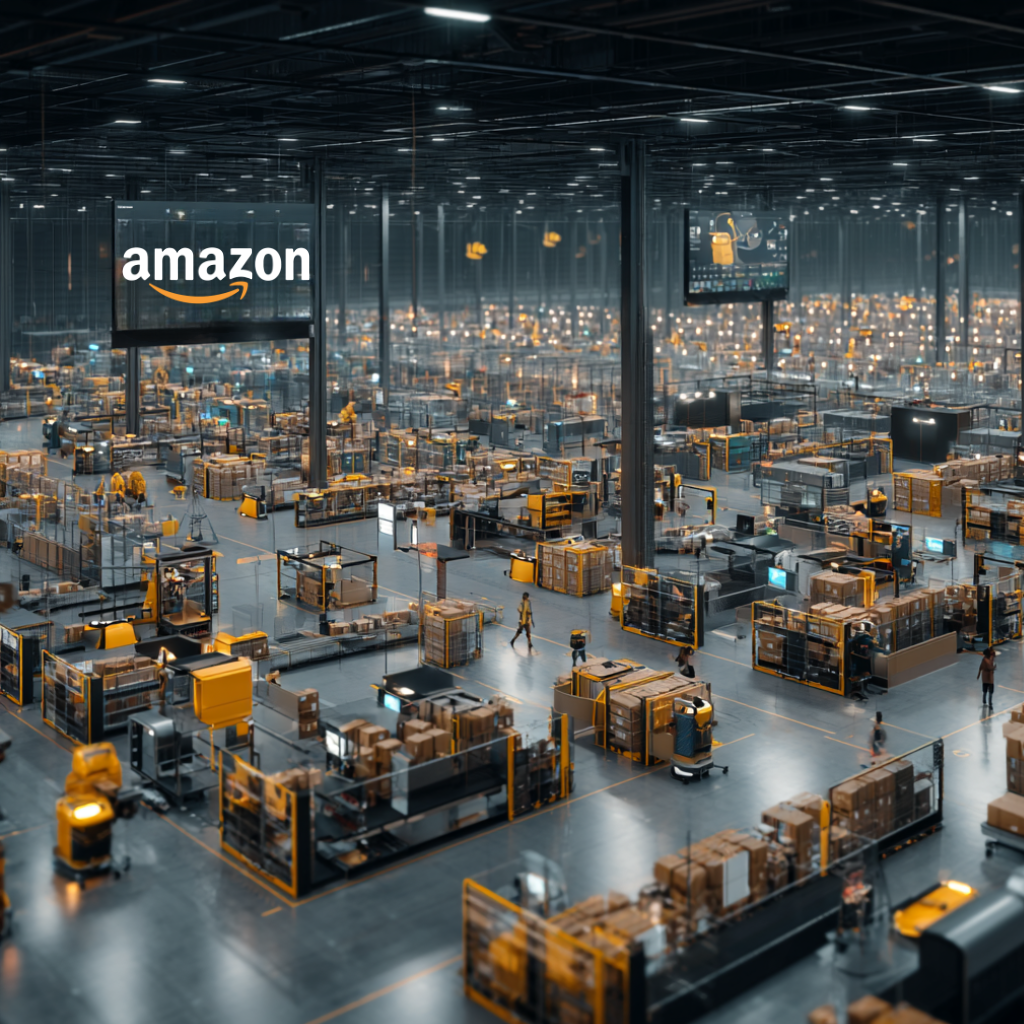Changing logistics driven by AI and robotics
In 2024, Amazon officially reached a symbolic milestone: more than one million robots deployed in its warehouses worldwide. This unprecedented expansion of physical automation is accompanied by a major technological shift: the integration of in-house artificial intelligence, interconnected with its entire robotic infrastructure. The objective is clear: to orchestrate a fleet of autonomous units in real time, in order to optimize, streamline and increase the reliability of the supply chain.
But the convergence of advanced AI and mass-market robotics raises both hopes and questions. What concrete uses will it be put to? What human skills will evolve? And what is the legal and ethical framework for this unprecedentedly large-scale automated system?
From Kiva to Proteus: the evolution of a robotic fleet
It all began in 2012, when Amazon acquired Kiva Systems, a start-up specializing in mobile warehouse robots.¹. This technology already enabled shelves to come to the operator, rather than the other way round. Since then, Amazon’s robotic range has expanded to include models such as Proteus (an autonomous mobile robot safe for human environments), Cardinal (a robotic sorting system), and Sparrow, capable of handling a wide variety of objects²capable of handling a wide variety of objects.
The announcement of the millionth robot in 2024 marks a change of scale… but also of paradigm, with the arrival of a central AI responsible for coordinating these systems.
AI at the heart of intelligent warehouses: what concrete capabilities?
This new AI, developed in-house, aims to optimize every level of logistics:
- Real-time navigation: dynamically adjusts robot trajectories to avoid traffic jams and maximize flows.
- Multi-agent orchestration: coordinates hundreds of machines according to order priorities, stock availability and human constraints.
- Predictive maintenance: by analyzing sensor data, it anticipates breakdowns and plans interventions.
- Intelligent allocation: resources (robots, people, storage areas) are automatically assigned according to peak workloads and local conditions.
Interfaces allow human supervisors to interact with the AI, adjust its parameters or challenge its decisions if necessary.
What jobs are being transformed by this AI + robotics duo?
Intelligent automation radically transforms the skills required:
- Logistics operators move from an execution role to that of fleet supervisor or manager of man-machine co-activities.
- Maintenance technicians need to understand how cyber-physical systems, sensors and embedded AI work.
- Hybrid positions are emerging: flow analyst, robotics coordinator, AI logistician.
This change calls for rapid skills upgrading, through continuing training and targeted qualification courses.
Ethical, legal and social issues
AI-driven mass robotization raises several points of vigilance:
- Transparency: AI must be explainable to human decision-makers.
- Liability: in the event of a malfunction, who is legally accountable?
- Algorithmic surveillance: what rights do employees have when faced with automated assessment tools?
- Social acceptability: how to maintain a sustainable human-machine balance?
The European AI Act and ISO standards for industrial robotics provide frameworks, but will have to evolve to keep pace with these tightly coupled systems.
Is Amazon foreshadowing the autonomous warehouse of tomorrow?
While Amazon today boasts the world’s most advanced automated logistics infrastructure, other players are following similar trajectories:
- Ocado in the UK relies on self-learning robotized grids.
- JD.com and Cainiao (Alibaba) invest in 100% autonomous hubs.
However, complete autonomy is still hampered by technical limitations: software interoperability, reliability in an open environment, and energy consumption.
Augmented logistics, but what kind of future for work?
Amazon tests a new frontier of automation: one where machines no longer simply execute, but coordinate, anticipate and learn³. This dynamic redefines the boundaries of logistics work, and raises the question of a new industrial social contract. While technology enables considerable gains in efficiency, it also calls for a rethinking of the place of the human being in the production ecosystem. Warehouses are becoming complex cyber-physical systems, in which supervision, critical analysis and human adaptability remain essential.
The widespread use of these devices could foreshadow other transformations in the manufacturing, distribution and urban logistics sectors. This raises the question of the skills that will need to be developed in the future: knowing how to cooperate with AI, interpreting its choices, retaining a capacity for independent judgment.
The challenge for the years to come will not just be to design smarter systems, but to ensure that they remain inclusive, equitable and adapted to human aspirations. The rise of logistical AI therefore raises less the question of what machines can do for us, than of what we choose to do together, with them.
Amazon is testing a new frontier in automation: one where machines no longer simply execute, but coordinate, anticipate and learn.
This dynamic redefines the boundaries of logistics work and raises the question of a new industrial social contract.
Is AI at the service of performance, efficiency – or should it also become a lever for professional emancipation?
References
1. Amazon Robotics. (2024). One Million Robots and Counting.
https://www.aboutamazon.com/
2. MIT Technology Review. (2024). “Inside Amazon’s Intelligent Warehouses”.
https://www.technologyreview.com/
3. European Commission. (2024). Artificial Intelligence Act – Final Text.
https://eur-lex.europa.eu/

